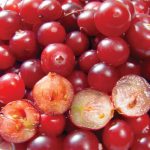 An indehiscent simple fruit with one to many seeds immersed in a fleshy pulp, supported by an endocarp less than 2 mm thick, the pericarp not differentiated internally by a hardened endocarp or airspace (Spjut, 1994).
An indehiscent simple fruit with one to many seeds immersed in a fleshy pulp, supported by an endocarp less than 2 mm thick, the pericarp not differentiated internally by a hardened endocarp or airspace (Spjut, 1994).
The most generalized type of fleshy fruit, derived from a single pistil, fleshy throughout, and containing usually several or many seeds; more loosely, any pulpy or juicy fruit.
The word berry first appeared in English a thousand years ago in a translation of an Old Testament passage referring to the “berries” used to make wine: berry originally referred only to grapes and did not acquire its wider, current meaning until the Middle Ages. Further back in its history, berry probably evolved from from an Indo-European source pronounced something like bha and meaning to shine: the notion, presumably, was that brightly coloured berries seem to “shine out” against the green foliage of a bush. The Indo-European source of berry also evolved into beacon, a device that employs a shining light to guide travellers, as well as other words that pertain to guiding or signalling, such as beckon and buoy. The Indo-European bha also became the Greek phos, meaning light, familiar in words such as photograph and photon. Berries and photons are therefore, from an etymological perspective, much the same thing: bright flashes against a dark background. The word berry is not related to Barry, a personal name that derives from the Irish Fionnbar, meaning fair-headed; nor, for that matter, is it related to beriberi, the name of a paralysing disease whose name, in Sinhalese, literally means weakness-weakness.
Simple, fleshy, usually indehiscent (not splitting open) fruit with one or more seeds (e.g., Gooseberry, Tomato).
A fleshy fruit without a hard stone (example: tomato).
A fleshy, indehiscent fruit containing several seeds.
A pulpy or fleshy fruit with more than one seed and formed from either a superior or an inferior ovary. The seeds are embedded in pulpy tissue.
Entire soft pericarp, as in the tomato or grape.
A fruit that is juicy or pulpy throughout, as a grape.
In botanical terms, a fleshy, indehiscent fruit produced by a single flower, as in the tomato or blueberry.
A fleshy or pulpy fruit that does not usually split open and that has one or more seeds.
An indehiscent soft fruit with many seeds (rarely one) immersed in a fleshy pulp.
A fleshy fruit containing one or more seeds, which do not have a stony inner coat around each seed (cf drupe).
In normal use, a small juicy fruit which is eaten entire and unpeeled; to the botanist, a fleshy fruit containing several seeds which does not open when ripe—including citrus fruits and the tomato.
A juicy, many-seeded fruit.
In normal use, a small juicy fruit which is eaten entire and unpeeled, or a small ornamental fruit that appears similar; but in botany often with the restrictive meaning of a fruit with seeds embedded in the flesh, lacking a hard stone, and which does not open when ripe—for example, a tomato.
